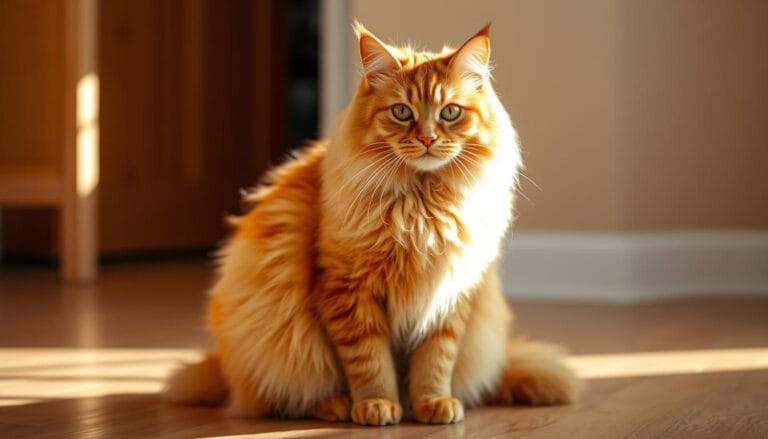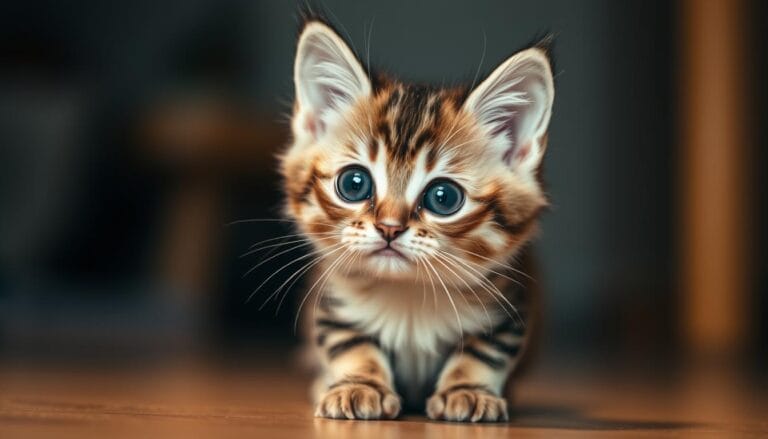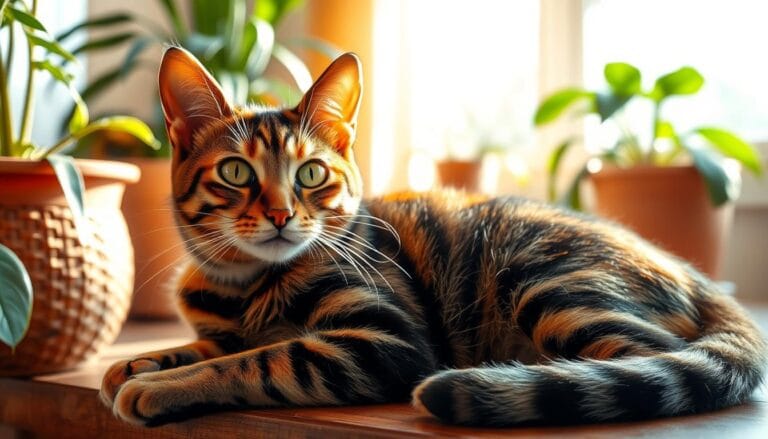Explore the Mysterious Black Footed Cat
Have you ever heard of the black footed cat? It’s a wild cat found in southern Africa’s savannas and grasslands. This cat is small but has powerful hunting skills. It’s known as the “world’s deadliest cat” because of its 60% hunting success rate.
Table of Contents
It eats between 8 to 14 meals every night. This makes it a top hunter in the animal world.
The black footed cat is rare and hard to find. Its numbers are going down because of humans and changes in its habitat. Learning about this cat shows why we need to protect it.
There are about 10,000 black footed cats in Africa. Most live in Botswana, Namibia, and South Africa. They live in savannas, grasslands, and deserts.
Key Takeaways
- The black footed cat has a hunting success rate of 60%, making it one of the most successful hunters in the animal kingdom.
- This species consumes between 8 to 14 meals every evening, showcasing its impressive hunting abilities.
- The black footed cat is found in the savannas and grasslands of southern Africa, with a population that is decreasing due to human development and habitat changes.
- Conservation efforts are necessary to protect the black footed cat, which is listed as “vulnerable” by the International Union for Conservation of Nature (IUCN).
- The black footed cats africa population is estimated to be around 10,000, with approximately 9,700 mature black footed cats living in the wild.
- The black footed cat is a mysterious and elusive species, with a small size and powerful hunting abilities.
- The species is also known as one of the smallest wild cats in Africa, with adult black footed cats weighing between 2 to 6 pounds on average.
Introduction to the Black Footed Cat
The black footed cat, also known as Felis nigripes, is a wild cat found in southern Africa. It’s interesting to learn about its scientific name, history, and where it lives. This cat is listed as Vulnerable on the IUCN Red List, showing its population is decreasing.
First spotted in the 19th century, the black footed cat has been studied and protected a lot since then. It can be found in the wild in Botswana, Namibia, and South Africa.
Scientific Classification
The black footed cat is part of the Felidae family and is known scientifically as Felis nigripes. Knowing its scientific name helps us understand its evolution, behavior, and how to protect it.
Historical Discovery
Discovered in the 19th century, the black footed cat has been studied and protected a lot since then. Its discovery has helped us learn about its habits, where it lives, and how many there are.
Geographic Distribution
The black footed cat lives in the wild in Botswana, Namibia, and South Africa. It’s found in different places like grasslands, savannas, and deserts in southern Africa.
Physical Characteristics and Appearance
The black footed cat is small and agile, with a unique look. Its coat color and pattern help it hunt. The cat’s coat can be reddish-fawn in the south and paler in the north.
This cat is tiny, with males weighing 1.7-2.4 kg and females 1-1.6 kg. They are 50-72 cm long, including their tail. Their eyes are six times better than humans’, making them great hunters. If you’re thinking about getting a black footed cat as a pet, knowing its physical traits is key.
Here are some interesting facts about the black footed cat’s physical traits:
- Only the pads and underparts of their feet are black
- They stand less than 10 inches at the shoulder, making them the smallest cat species in Africa
- They have a kill rate of 60% during hunts, which is higher than that of lions and leopards
In conclusion, the black footed cat’s physical traits make it a unique and fascinating creature. Whether you’re thinking of getting one as a pet or just want to learn more, knowing about its physical characteristics is crucial.
Habitat Preferences and Distribution Range
The black footed cat lives in different places in southern Africa. They like savannas, grasslands, and deserts. They need places with shrubs and trees, up to 6,600 ft (2,000 m) high.
They are found in countries like Namibia, South Africa, and Zimbabwe. South Africa has the most black footed cats.
Black footed cats like certain places to live. They need a certain size of territory to survive. They are important for their ecosystem’s health.
Preferred Ecosystems
Some of the black footed cat’s favorite places are:
- Grassland
- Savanna
- Karoo semi-desert
These places give them shelter, food, and water. They are well suited to their environment. But, they need our help to survive.
Environmental Requirements
Black footed cats need specific things to live. They like low vegetation, rocky areas, and water. Their homes are key to their hunting and survival.
Hunting Abilities and Prey Selection
The black footed cat is a skilled hunter with many adaptations. It has a 60 percent success rate, making it one of the top predators. This is much higher than lions and tigers, which succeed only 20-25 percent of the time. Its hunting skills are key to its survival and help keep the ecosystem balanced.
This cat hunts over 40 different species, including small mammals, birds, and reptiles. It hunts alone, using its stealth and agility. Its small size lets it hunt in dense areas and tight spaces. In one night, it can eat up to 14 small animals, showing its hunting prowess.
Some key facts about the black footed cat’s hunting abilities include:
- Hunting success rate: 60 percent
- Prey species: over 40 different species
- Hunting style: solitary and stealthy
- Prey consumption: up to 14 small animals per night
If you’re thinking of having a black footed cat as a pet, you should know about its hunting. While you can’t replicate its natural habitat, a good diet and activities can help. But remember, these cats are wild and may not be the best pets for everyone.
Behavioral Patterns of Black Footed Cats
Exploring black footed cats reveals their behaviors are shaped by their environment. They are most active at night, which helps them survive. If you’re thinking of getting one as a pet, knowing their natural behaviors is key.
Black footed cats live alone, except for mating. They communicate through sounds, smells, and body language. For example, they hiss and spit to scare off others. As a pet owner, you’ll need to create a space that meets their needs.
Nocturnal Activities
Black footed cats are expert hunters, hunting at night. They can catch up to 14 rodents or small birds in one night. Their speed and agility make them great hunters, reaching up to 30 mph.
Communication Methods
Black footed cats communicate in many ways. They meow, purr, and use scent and body language. Understanding these methods helps you bond with your pet and care for them properly.
Reproduction and Life Cycle
The black footed cat has a special way of reproducing, fitting its breeding season to its African environment. Female black footed cats usually have two kittens in the Southern Hemisphere summer. This season runs from October to March.
The life cycle of the black footed cat is key to its survival. It helps keep the ecosystem balanced. Key aspects of the black footed cat’s life cycle include:
- Average gestation period: 66 days
- Range weaning age: 30 to 35 days
- Age at sexual maturity (females): 14 to 21 months
- Age at sexual maturity (males): Average 14.5 months
In the wild, black footed cats can live up to 13 years. In captivity, they can live up to 15.6 years. Knowing how they reproduce and live is vital for saving this endangered species in Africa.
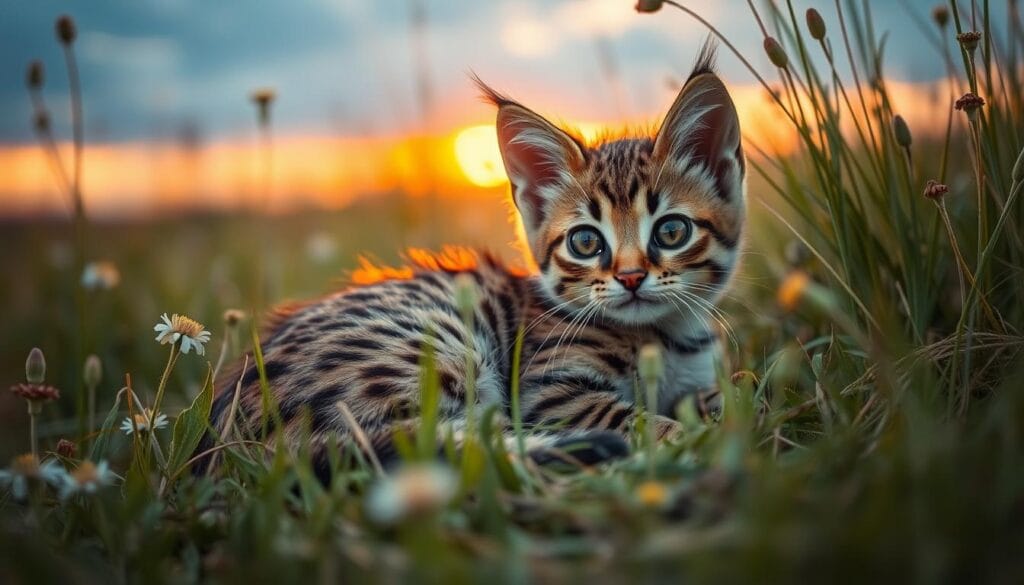
Can You Keep a Black Footed Cat as Pet?
Keeping a black footed cat as a pet is unique but requires careful thought. It’s important to consider the legal, care, and challenges involved. Think about bringing a pet black footed cat into your home.
Before deciding, research the laws about exotic pets like black footed cats in your area. Some places have strict rules about owning wild animals, including black footed cats.
Legal Considerations
In the United States, owning exotic animals is regulated by CITES. You’ll need permits and licenses to keep a black footed cat as a pet.
Care Requirements
Caring for a black footed cat is demanding. They need specific food and living conditions to stay healthy. You’ll need a good enclosure, balanced diet, and regular vet visits.
Potential Challenges
Keeping a black footed cat can be tough. They are most active at night and need lots of space. Think about your home’s size and how much time you can spend with your pet.
Here are some things to think about when deciding to keep a black footed cat:
- Space: Do you have enough space in your home for a suitable enclosure?
- Time: Do you have enough time for regular care and attention?
- Resources: Do you have the money and equipment needed for your pet’s care?
Keeping a black footed cat can be rewarding. But, it’s crucial to weigh the challenges and responsibilities. With proper care, a black footed cat can bring joy and companionship for years.
Conservation Status and Threats
The black footed cat is listed as vulnerable on the IUCN Red List. Several threats impact its population. By understanding these threats, we can help protect black footed cats in Africa.
Recent data shows the global black footed cat population is under 10,000 mature individuals. With fewer than 1,000 in any sub-population, their numbers are declining. Their secretive nature makes counting them hard, but the trend is clear.
Current Population Status
The black footed cat population is under 10,000 individuals. About 40% of studied populations die each year, mainly from predators and disease. Habitat loss and human-wildlife conflict also threaten their numbers.
Major Threats
Major threats to black footed cats include:
- Predation by caracals and black-backed jackals
- Disease, such as amyloidosis, a genetically inherited disease
- Habitat loss and degradation
- Climate change, leading to more frequent and severe droughts
Protection Measures
The black footed cat is listed on Appendix I of CITES. This means trade in the species is banned, except in rare cases. In South Africa, they are protected under the National Environmental Management: Biodiversity Act. A permit is needed for any activity involving them.
Research and Scientific Studies
Thinking about getting a black footed cat as a pet? It’s key to know the research and studies on this species. Many studies have uncovered its behavior, ecology, and conservation status.
Research shows the black-footed cat is a top hunter. It can catch up to 14 rodents and birds in one night. This is important for saving this rare cat.
Some important facts about the black-footed cat include:
- They are one of the world’s smallest cats, with adult weights ranging from 2 to 3 pounds.
- They have a high population density, but are often overlooked due to similarities in their distributions with larger species.
- Conservation efforts, such as the Urban Fishing Cat Project, are necessary to protect the black-footed cat and its habitat.
Thinking about a black footed cat as a pet? It’s crucial to understand the challenges and responsibilities. The black-footed cat is listed as Vulnerable by the International Union for Conservation of Nature (IUCN) Red List. There are only about 10,000 left in the wild as of 2019. San Diego Zoo Global is part of the effort to save this cat.
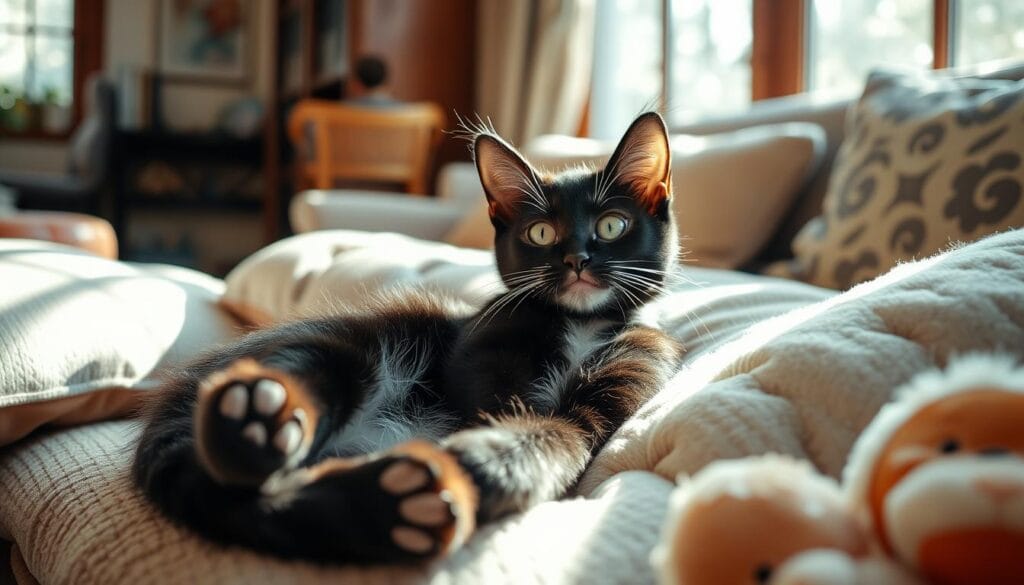
Cultural Significance in African Heritage
The black footed cat is very important in African culture. It has its own place in art, literature, and stories. These show how special the cat is.
In many African cultures, the black footed cat stands for agility and stealth. It can live in tough places and catch small animals. It’s also seen in traditional medicine and spiritual practices. There, it’s linked to protection and good fortune.
Traditional Beliefs
Old African beliefs about the black footed cat focus on its looks and actions. For instance, its black feet are thought to have healing properties. Its night habits are seen as a sign of spiritual guidance. These ideas have been passed down for many years.
Modern Cultural Impact
Today, the black footed cat is a key symbol in African conservation. Many groups are working to save its home and stop it from disappearing. You can help by learning more about the cat and its role in nature. This way, you can spread the word about why we need to protect it.
By understanding the black footed cat’s cultural value, we can help it survive. This amazing animal needs our respect and care. By supporting conservation, we can make sure it stays around for a long time.
Relationship with Other African Wild Cats
Exploring African wild cats, you might ask about the black footed cat’s relationship with others. This cat, a potential pet black footed cat, holds a special spot in the ecosystem. It interacts with other wild cats like the African wildcat and the serval.
Research shows the black footed cat rarely mixes with domestic cats. This is good news for saving them. But, domestic cats can still harm black footed cat numbers, mainly in crowded areas. If you’re thinking about a black footed cat pet, know how important it is to be a responsible owner. This helps protect wild cat populations.
Here are some key points about the black footed cat’s relationship with other African wild cats:
- Low level of hybridization with domestic cats
- Coexistence with other African wild cats, such as the African wildcat and the serval
- Potential threat from domestic cats in areas with high human population density
In conclusion, the black footed cat’s relationship with other African wild cats is complex. Learning more about these animals helps us appreciate conservation and responsible pet ownership. This is crucial for exotic pets like the pet black footed cat.
Conclusion: Protecting Earth’s Smallest African Cat
The black-footed cat is a remarkable and unique species. It needs careful conservation to survive. These cats are small, great hunters, and live in a limited area.
You can help protect the black-footed cat. Support conservation efforts like breeding programs and habitat restoration. Raising awareness and advocating for their protection is crucial.
Research, monitoring, and teamwork are key to a bright future for the black-footed cat. Preserving this cat helps protect Africa’s biodiversity. It also keeps ecosystems in balance.
FAQ
What is the scientific classification of the black-footed cat?
The black-footed cat is known as Felis nigripes. It lives in the wild in Botswana, Namibia, and South Africa.
When was the black-footed cat first discovered?
It was discovered in the 19th century. Since then, it has been studied and protected.
What are the physical characteristics of the black-footed cat?
It’s small and agile, with a unique look. Its coat helps it hunt in its environment.
Where does the black-footed cat live?
It lives in savannas, grasslands, and deserts. Its home helps it survive and keep the ecosystem balanced.
How does the black-footed cat hunt?
It’s a skilled hunter. Its hunting ways help it survive and keep the ecosystem balanced.
What are the behavioral patterns of the black-footed cat?
It’s active at night. Its behavior helps it survive and keep the ecosystem balanced.
How does the black-footed cat reproduce?
It has a unique way of reproducing. This helps it survive and keep the ecosystem balanced.
Can you keep a black-footed cat as a pet?
It can be a rewarding pet. But, it’s a big responsibility and requires careful consideration.
What is the conservation status of the black-footed cat?
It faces threats like habitat loss and climate change. Its survival depends on conservation efforts.
What research has been done on the black-footed cat?
Much research has been done. It has helped us understand its behavior and conservation status.
What is the cultural significance of the black-footed cat in African heritage?
It holds a special place in African culture. It’s celebrated in traditional beliefs and modern culture.
How does the black-footed cat interact with other African wild cats?
It has a complex relationship with other wild cats. This reflects its role in the ecosystem.
There are no reviews yet. Be the first one to write one.


